Rocket Lab’s next mission, targeted for no earlier than Feb. 28, will be the first from a new launch pad at the company’s private spaceport in New Zealand, an addition officials said could double the flight rate of Electron launchers.
The new launch pad, named Launch Complex 1B, lies 383 feet (117 meters) from Launch Complex 1A, the pad Rocket Lab has used for all 23 of its Electron rocket missions to date, according to a company spokesperson.
“With two launch pads, we have doubled our capacity and reached ultimate launch flexibility,” said Shaun D’Mello, Rocket Lab’s vice president of launch. “This means when a customer needs us, we’ve got a pad ready.”
Peter Beck, Rocket Lab’s founder and CEO, said the company built the new pad to allow a higher cadence of missions. He said the new pad is “basically a replica of Pad A with some slight improvements.”
“Now we can process two rockets and launch two rockets at the same time,” he said.
Rocket Lab, a U.S.-based company which builds and launches rockets in New Zealand, has been the most successful firm in a wave of new entrants to the small satellite launch industry, securing contracts from commercial customers, the U.S. military, and NASA. Rocket Lab has also diversified its business into space operations and satellite manufacturing.
The company’s Electron rocket, which stands 59 feet (18 meters) tall, is sized to haul small satellites into orbit. The Electron can haul up to 440 pounds (200 kilograms) to a 310-mile-high (500-kilometer) polar orbit, according to Rocket Lab.
Rocket Lab began launching Electron rockets in 2017 from its own private spaceport on Mahia Peninsula, located on the east coast of New Zealand’s North Island. Launches from there can place payloads into a range of orbits.
Launch Complex 1B has its own storage tanks for kerosene and liquid oxygen used by the Electron rocket. The two pads at Mahia Peninsula are independent from one another, but the facilities share a rocket integration hangar and clean rooms for processing satellites for launch.
Beck said the two pads could support two Electron launches within a day of one another.
“Our goal here would not be to launch within hours, but certainly within a day or so, there would be no problem at all,” Beck said. “But it really is a human resources issue, not an infrastructure issue.”
A dedicated Electron launch sells for about $7 million, significantly less expensive than larger rockets. But bigger boosters, such as SpaceX’s Falcon 9, can deploy much heavier cargo, aggregating numerous small satellites on a single mission, spreading costs among multiple customers.

Rocket Lab is developing a next-generation rocket called the Neutron that can carry heavier payloads than the Electron. It is slated to debut in 2024 with a reusable first stage, seeking to better compete with rockets like the Falcon 9.
Until the Neutron enters service, Rocket Lab will continue flying Electron launchers from its two pads in New Zealand, plus a new launch site at Wallops Island in Virginia.
“For us, it’s really important to have launch pads in both hemispheres of the planet,” Beck said. “We have two launch pads in the southern hemisphere, one launch pad in the northern hemisphere.”
Some U.S. government customers might prefer to launch their missions from a U.S. spaceport, and the Virginia pad, named Launch Complex 2, gives Rocket Lab the ability to do that.
Rocket Lab originally aimed to launch the first mission from Virginia in 2020, but the schedule has been delayed by NASA’s certification of a new flight termination system, an autonomous destruct mechanism that would be used to terminate a flight if the rocket flew off course.
In January, NASA said it released software code from its autonomous flight termination unit to the launch industry. That allowed Rocket Lab to begin integrating the software with their launch vehicle.
NASA’s autonomous flight termination unit was developed in cooperation with the U.S. military and the Federal Aviation Administration. Many commercial launch companies, including Rocket Lab, already use autonomous flight safety systems, but the mechanisms are proprietary and designed for use on a single type of launch vehicle.
Autonomous flight safety systems are replacing older manual range safety systems, which required a safety officer on the ground to send a destruct command if a rocket strayed from its flight corridor.
The NASA system will be customizable to support different types of rockets flying from different spaceports. NASA said that made development of the flight termination unit more complicated, but officials hope the effort will pay off by allowing any emerging U.S. launch provider to use it, without needing their own flight safety system.
Rocket Lab will be the first launch company to use the NASA flight termination unit.

Beck said Rocket Lab is going through a process to certify NASA’s software for the flight termination unit, but he’s optimistic the system will be ready soon.
“We’re seeing a way clear now, with enough certainty to start planning the first launch attempt out of there,” he said. “We’re much more hopeful this year of seeing that pad activated, given where NASA is at the moment with their certification.”
Due to the delays, at least two missions originally slated to launch from Virginia have been moved to Rocket Lab’s New Zealand launch site. One was the launch of the U.S. Space Force’s Monolith satellite, which successfully flew into orbit last year. Another is the launch in the next few months of NASA’s CAPSTONE mission, a CubeSat that will test communications and navigation technology near the moon.
Beck has previously stated that building and activating Rocket Lab’s own private spaceport was a particular challenge in getting the Electron program operational. But it turns out activating Launch Complex 2 in Virginia will take longer.
“History will say we had LC 1 operational faster than we had LC 2 operational,” Beck said. “Building your own private site is an incredibly painful process, and I think others in the industry are learning that as well, so this is not a trivial thing to build your own launch site, a private one.
“But I think the decisions here were exactly right,” Beck said. “LC 1 has so much operational benefit. If we roll a rocket out to the pad, and we look at the sky and say, ‘You know what, today’s not the day,’ then we just come back tomorrow. And there is not range scheduling. There is no congestion. There are no range fees. It’s just utopia from that perspective. And then having an additional pad there just gives us even more flexibility and more opportunities.”
Rocket Lab has not announced a launch and landing site for its next-generation Neutron rocket.
“It is fair to say that we are running a very competitive process for Neutron’s home, and we’ll be making an announcement about that very, very shortly,” Beck said.
“It’s not just a launch site and a landing site,” he said. “It’s the entire factory. Having the factory close to the launch site is fundamental to really reducing those costs. But also Neutron is a very large diameter vehicle, and transporting that down the road is not an easy thing.”
Email the author.
Follow Stephen Clark on Twitter: @StephenClark1.
